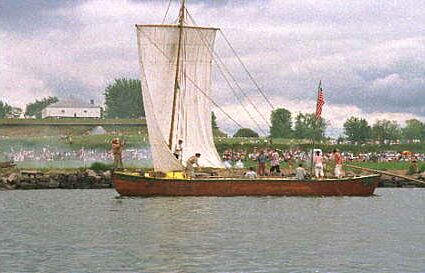The attraction of Canada...
Settlement in Canada up to the early 19th century was slow and unsure. Governing bodies changed, territories changed, trade changed, and the reasons for coming to Canada changed. The single largest influx was of the United Empire Loyalists who fled the United States after the American Revolution in significant numbers and settled primarily in Nova Scotia, newly-formed New Brunswick and Prince Edward Island. About 10,000 of the estimated 40,000 Loyalist emigrants settled in Upper Canada.
By 1820, Upper Canada was becoming very attractive to those wishing to emigrate from countries like England, where life for many was very difficult and held little promise of a prosperous future. With the Industrial Revolution gaining momentum, entrepreneurs looked to the New World to open new businesses, or to expand existing Old World businesses. Jobs and even small business opportunities began opening up for the city's poor and for the peasant rural population in both the Old World and the New. Virtually every industry was a "growth industry". While few of the employed accumulated any real wealth, it was still a step up for many from the impoverished life of the era. Emigrating to Canada became a way out - and up - for thousands of people.
For many who worked or owned land in the Old World, rents and taxes were oppressive. Canada had reserved land for the Clergy making the remainder tythe-free; Canada charged no rent on land in use; and Canada charged nominal taxes, which would rise and fall based on profit - meaning lower, or no, taxes paid in a bad year. This all amounted to a significant enticement to emigrate and start anew.
Government encouragement...
To encourage the inland settlement of Canada by stable, loyal pioneers, then Lieutenant Governor Simcoe offered conditional 200-acre grants. The land of Upper Canada (Ontario) was divided up into these parcels which could well be afforded or acquired by way of the free grant. United Empire Loyalists and their family members, those having served in the Military and their family members, and certain others could receive land - often with all fees waived. Advertisements were sent out to the most desirable potential settlers, like the successful German settlers in Pennsylvania and others.
As a means of encouraging the raising of capital while providing settlers with land and employment, the government sold vast areas of crown lands and clergy reserves across southern Ontario to The Canada Company, formed in the early 1800's by a group of English businessmen. The Canada Company managed the grants, leases and sales of much of the Crown Land, and was still in business up until the early 1950's.
As to the kinds of land acquisition arrangements available, there were basicaly three. A free grant awarded the grantee the right to occupy a parcel of Crown land with no transfer of ownership until several conditions were met, then a deed would be issued. A lease usually involved the Canada Company, and was often converted into a sale. A sale involved either the Canada Company (resulting in the issuing of a deed) or the Crown (resulting in the issuing of a patent).
Note : A township in Ontario is usually rectangular in shape, unless it borders a major river or lake. Townships are divided into concessions. Each concession is a strip of land 1¼ mile wide. Concessions can run in any direction and are usually separated by a road. Concessions are numbered with Roman Numerals (V, IV, etc). When concessions do not run the length or width of the township because of water, they are usually labelled with letters (A, B, etc). A gore is a part of a township that does not fit into the regular shape. Concessions are divided into lots that use Arabic numbers (3, 4, etc). Originally lots were 200 acres, which could then be easily divided into parcels of 100 acres, and further subdivided into lots as small as just a few acres.
By 1830, thousands were emigrating to Upper Canada each year. Between 1825 and 1846, it is believed that some 600,000 emigrants settled in all parts of Canada. The population of the three maritime colonies of Nova Scotia, New Brunswick and Prince Edward Island rose from 80,000 in 1800 to over 500,000, Lower Canada's population increased from 480,000 in 1825 to 890,000, and the population of Upper Canada grew from 100,000 in 1812 to 952,000 - all by mid-century. Most of the immigrants arrived from the British Isles: 20% British, 20% Scottish, and 60% Irish, in round numbers.
Joseph Longhurst and family...
Joseph Longhurst was born November 29, 1787, in Capel Surrey England (follow this link to read about Surrey England and neighbouring Hampshire England). He is descended from John Longhurst, born c1515. Joseph was baptized December 13, 1789. His parents were John Longhurst (Jr.) and Mary Wheeler.
A record at familysearch.org for Joseph Longhurst that also links to his wife and children is https://www.familysearch.org/tree/person/details/LZCG-8JC
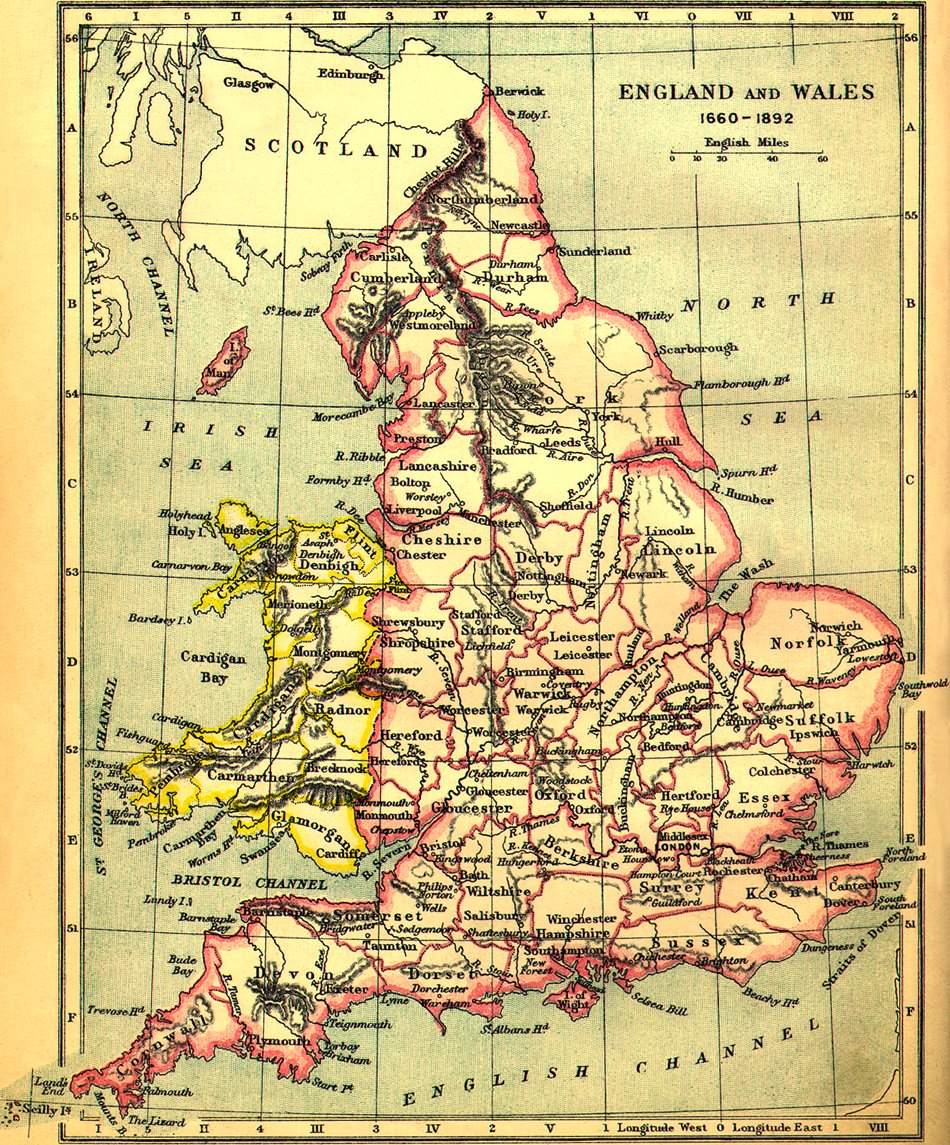 |
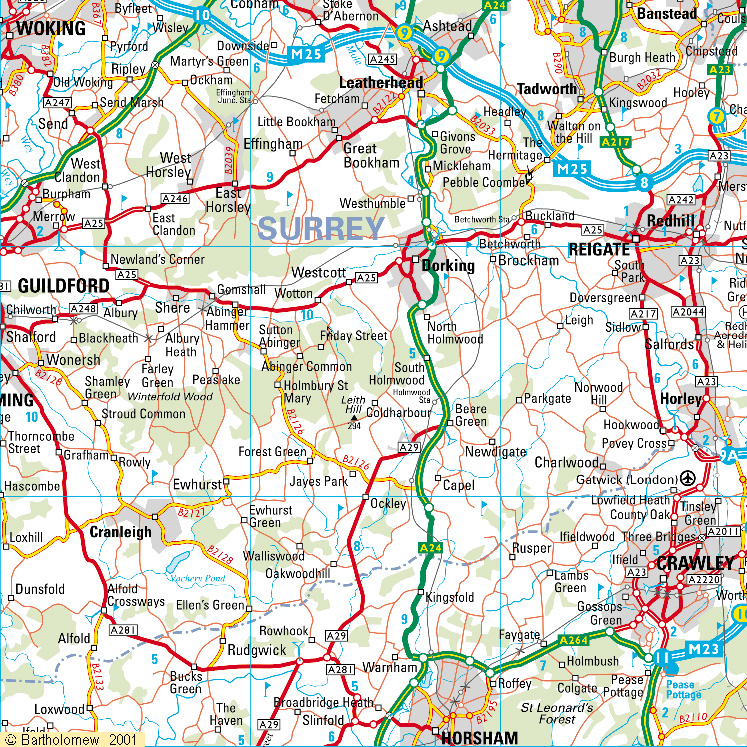 |
Sarah Haysman may have been born August 18, 1786, in Kent, the county immediately to the east of Surrey. Her parents were _________ and _________. Joseph and Sarah were married on January 1, 1809, in Edenbridge Kent England. They lived in nearby Dorking. Joseph was a carpenter.
 |
"Banns", an Old English tradition, are announcements of an intended marriage publicly made to allow anyone to contest or protest the marriage. According to the document above, the banns were published thrice, first on November 27, 1808, and the marriage took place on January 1, 1809. The parish name, Edenbridge (Kent, England), only appears in the entry No. 315 at the top of this same page as if by accident. Traditionally the word Bachelor is written in, so Edenbridge was crossed out and Bachelor was added beside it.
 |
As read and interpreted by researcher Dawn Shilcock... Banns of Marriage between Joseph Longhurst Batchelor and Sarah Haysman Spinster were published Nov 27th, Dec 4th & 11th 1808 by me Thos Hayton, Curate. Joseph Longhurst of his Parish Batchelor and Sarah Haysman of this Parish Spinster were Married in this Church by Banns this first Day of January in the Year One Thousand Eight Hundred and nine by me Thos. Hayton, Curate This Marriage was solemnized between Us Joseph Longhurst X his mark Sarah Haysman X her mark In the presence of Stephen Haysman X (his mark) Willm Saxby Parish Clerk |
|
To see the full page enlarged, click on it. |
(non-italicized text is printed into the blank form sheet, four records per page) |
Since Joseph, Sarah and the witness Stephen Haysman all signed with an "X", it may be that both families were illiterate. This would mean that neither Joseph nor Sarah could likely check any data written into any public documents - including the spelling of the bride's surname. Whether or not the children would be able to read and write is not known at present.
Joseph and Sarah had nine children : George (born 1809), Charles (born c1811), John (born c1813), James (Sr.) (1816), Anne (born c1819), Frederick (born c1821), Jesse Isaac (born 1824), Caroline (born c1827), and Hester (Esther, born 1832, died 1832 en route to Canada).
In 1830 and 1831, an uprising in southern England by unemployed agricultural workers that threatened the governing aristocracy resulted in a plan to assist poor families in migrating to areas of the world where life's prospects were better. In 1832, Joseph and his family emigrated to Canada as part of what is known as the Petworth Project, described in some detail below, and extensively in publications available at this website...
The Emigrant's Guide to The Canadas, 1822
(links to the full text)
by William Watson, Esq. (1822) gives an excellent description of the times, as well as the usual steps needed to be taken by any emigrant to Canada to gain a foothold in this country.
Here are several poignant quotes:
"It is a common opinion in Ireland, that any person emigrating to the Canadas can obtain Land gratis; such a report sounds sweetly, especially to those who wish to become Agriculturists, or may have been labouring under the Agents of Absentees, Rack Rents, &c. &c."
"A poor Emigrant, proving that he is unable to pay any fees, will get fifty acres of land free."
"Five Acres to be cleared to every hundred acres granted, a Log-house, sixteen feet by twenty, roofed and finished. Every lot of two-hundred acres must have a Road cut at each end, 33 feet broad; but a person getting only half a Lot, (a hundred acres) cuts his road only at one end. The Clear Land must be fenced, the Logs and Brushwood burned, and the ground fitted for the harrow."
"When the Settling Duties are accomplished, and an Affidavit made to that effect by two Witnesses before a Magistrate, the Settler can obtain his Deed."
While land could be gotten by qualified individuals for "free", those who succeeded in retaining their land and prospering usually had some money going in.
"Land is not to be obtained for nothing in the Canadas. Let the expense of going so far, Government Fees, Settling duties, clearing the land, &c. &c. be considered, and then count the cost, the justice of my observation will be amply proved."
"A man, with a large family, wishing to embark prosperously and extensively inland, would require £300, though many have but very little and struggle to acquire properties. A man can do more with £300 in this country than be can with £700 in Ireland."
As to choosing Upper Canada over the United States, or anywhere else for that matter...
"The wisdom and goodness of GOD are remarkably conspicuous..."
"Many Emigrants who went to the United States have left that country and settled in the Canadas, where they enjoy superior health, and have obtained cheaper and better land in the latter than they could in the former."
"The Land in Lower Canada is not so good as in the Upper province..."
And as to those who would most likely prosper...
"Of all descriptions of men, the Canadas answer best a poor hardy labourer who is either single or can be assisted by able and dutiful sons. Such will not feel the loss of society, and can well bear a state of equality."
"Notwithstanding the many advantages peculiar to the Canadas, they are only fit for hardy, industrious and experienced men, who can be contented with every society, and whose future expectations are very moderate."
Petworth Emigration, 1832
(from information at this website...)
In the beginning of the year 1832, a Committee was formed at Petworth, under the sanction of the Earl of Egremont, to afford assistance to such persons as might wish to emigrate to Canada; and the following paper was printed and circulated in the neighbourhood.
_________________
Petworth, March 1st. 1832
Information to Persons desirous of emigrating from this Neighbourhood, to Upper Canada.
In the parish of Petworth, where the Earl of Egremont possesses nearly the whole of the land, his Lordship has signified his intention, of defraying the whole of the expence,[sic] of persons of approved character, wishing to proceed to Upper Canada; and, in any other parish, in proportion to the property he owns in that parish. Encouraged by this liberal support, an engagement has been entered into, for the ship LORD MELVILLE, 425(1) Tons register, A. 1. coppered and copper fastened, and sheathed, with 7 feet height between decks, and extra ventilating scuttles, which is to be comfortably fitted up at Portsmouth, and to sail from thence for Montreal, direct, on the 5th of April next. Passengers to be on board on the 4th at latest. A superintendent (with his wife and family) goes out with Lord Egremont's party, and will conduct them direct to York, in Upper Canada, (in, or near, which city he intends to settle) paying every attention to their comforts on the route.
A surgeon also sails in the ship, whose duty it will be to attend (gratis) to the health of the passengers. The whole of the expence from Portsmouth to York, Upper Canada, is calculated, for adults, 10£. Children under fourteen years, 5£. Infants under 12 months, free.
On these terms, any persons, wishing to avail themselves of the peculiar advantages thus presented, may join the Petworth party, if they signify their intention to do so, on, or before Saturday the 17th, day of March instant; and make a deposit (at the printer's) of 2£, for every adult passenger, and 1£, for every person under 14 years; engaging to pay the remainder, on going on board.
Persons particularly wishing to board themselves, may be conveyed with the Petworth party, from Portsmouth, to York, in Upper Canada, medical attendance, and every other expence included, for 5£; or to Montreal only, should they not wish to proceed any farther, nor to avail themselves during the voyage of the assistance of the superintendent, for 3£. 10. 0; but it is probable that they would find more comfort, and on the whole, less expence, by being boarded under his management. The sea stores contain brandy, porter, and several other articles, likely to contribute to the comfort of the passengers; to be given out, under the direction of the surgeon, as circumstances may require.
Experience has proved, that the practice pursued on many former occasions, of landing emigrants at the first American port, and leaving them with a small sum of money in their pockets, has exposed them to every kind of fraud and imposition; they having been soon pillaged of what they had, or led to squander it idly away, and thus left pennyless, and without employment in a strange land. To guard against this evil, the above plan has been adopted, of conveying the emigrants, AT ONCE, to where work can, with certainty, be found; and placing them under the charge of a superintendent, whose business it will be, in conjunction with the government agent, to attend to them till that object is obtained; little or no money is therefore required by labouring emigrants, on their arrival: still, any sum paid to the Petworth Committee, will be repaid at York, Upper Canada, into their hands, or to their account, as may be desired.
Under these arrangements an excellent opportunity is afforded to respectable unmarried females, who may wish to join any relations or friends, already settled in Upper Canada; as they could be placed under the immediate protection of the superintendent and his wife. *List of Necessaries for Emigrants to Upper Canada
Families should take their... bedding, blankets, sheets, &c., pewter plates or wooden treuchers, knives, forks, and spoons, metal cups and mugs, tea kettles, and saucepans, working tools of all descriptions. (A large tin can, or watering pot would be useful.)
Single men must have... a bed or mattress, a metal plate or wooden trencher, some kind of metal cup or mug, a knife, fork, and spoon - all, or any of which, may be procured at Portsmouth, if the parties arrive there unprovided.
The following is the lowest outfit, recommended to Parishes for their Laborers, of course, including such articles as they already possess...
A fur cap, a warm great coat, a flushing jacket & trowsers[sic], a duck frock and trowsers, a canvas frock and two pairs of trowsers, two Jersey frocks, four shirts, four pairs of stockings, three pairs of shoes, a bible and prayer book. Women in the same proportion, especially a warm cloak.
All of the above may be purchased at Petworth.
It is also a matter of great importance, that emigrants should take with them a good character (reference), (if they should have the happiness to possess one,) fairly written, and well attested; also, copies of marriage or baptismal registers, or any other certificates or papers likely to be useful; the whole to be inclosed in a small tin case.
_________________
Soon after the publication of the above, all the passages on board the Lord Melville, were engaged; and the Committee were compelled, for a time, to decline receiving any more deposits, but the applications continuing to be very numerous, some of them from parishes in the adjoining counties, and from places not originally contemplated, (it having even been proposed to send one party overland from Royston, in Cambridgeshire) they at length decided upon engaging the Eveline, another first class ship, and made arrangements, that both vessels should be brought up into the harbour of Portsmouth, and sail from thence, on the same day. This accordingly took place, on the 11th of April, the number on board the two ships being as stated hereafter.
The passage was unfortunately longer, and more rough, than is usual at that season, to the great, though unavoidable, discomfort of many on board; but the whole party, excepting one infant in each ship, (Hester Longhurst, and one other, died at sea) reached Quebec, alive, and generally speaking, in good health. At that place, one unfortunate young man was drowned, in consequence of excess in drinking, and another, from the same cause, at Montreal. The party quitted the latter place, just two days before the appearance of the cholera there, and (with one or two exceptions) entirely escaped its ravages, during their progress up the country; although it afterwards, unhappily, broke out, with great violence, where some of them had settled.
After the emigrants arrived at York, they were forwarded to various places in the province, by direction of the Lt. Governor Sir J. Colborne, and either settled on land, or got immediate employment, at high wages. They seem indeed to be so happily distributed, as to afford a hope, that, in the language of some of their own letters, they will not only, "do themselves some good," but also be able, materially to assist the first efforts, of those of their former neighbours, who may hereafter be disposed to join them: and it is not, perhaps, going too far, to indulge the expectation, that some of the settlements formed by these Sussex emigrants will, eventually, become of great importance in the province. One, in the fast improving government township of Adelaide, to which a considerable number of them was sent, has already been called by the Surveyor, "Goatcher," after the name of an industrious, and worthy man, from Pulborough, in this County, who had charge of the party in the Eveline.
For more colour, please read the 1832 Emigrants Handbook For Arrivals in Quebec. This document tells a great deal of what it was like to emigrate to Canada at that time.
Coming to Canada...
The Eveline...
The family of Joseph Longhurst was sponsored financially by the Dorking Emigration Society, in particular a piano manufacturer named Broadwood. Joseph and Sarah traveled to Canada from Dorking in 1832 with their nine children, including son George with his family. They all made their journey to Canada on the ship Eveline, as part of the Petworth Emigration of 1832.
The Eveline, a first class ship, 301 tons, sailed from Portsmouth (Spithead) on April 11, 1832, under Captain Royal, and arrived at Quebec May 28, 1832. The superintendent appointed by the Petworth Emigration Committee for this group was Stephen Goatcher. "250 to feed every day", according to a letter written by Goatcher. Other families aboard with the Longhursts were : Boxall, Capling (Caplin, Caplain, Capelain), Cooper, Evans (née Tribe), Hill, Hilton, Luff, Neal, Phillips, and Stedman.
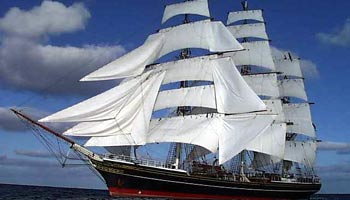 |
This is the 300 ton clipper ship Amsterdam. Perhaps the Eveline looked something like this.
Of the journey, Goatcher also states: "I lived with Captain Royal, in the ship Eveline, in the cabin, on fresh meat and fowls." In an account written by Charlotte Willard (nee Longhurst, but presumed not directly unrelated, as there no mention of Joseph's family in her letter, and no mention of the Willard family in Rebecca Weller Longhurst's letter): "They had plenty of every thing in the (Captain's) cabin, we had nothing but musty biscuit and salt beef..."
The passage was unfortunately longer, and more rough, than is usual at that season, to the great, though unavoidable, discomfort of many on board; but the whole party, excepting one infant in each ship, (Hester Longhurst, aboard the Eveline and one other aboard the Lord Melville, died at sea) reached the New World, alive, and generally speaking, in good health. After landing in Quebec (City) on May 28, 1832 and spending just two days, the family moved on to Montreal. The party left Quebec just two days before the appearance of cholera there, and were untouched by the disease during their travels to York. No illnesses or deaths in the Longhurst family are noted as having been due to the epidemic.
According to fellow passenger John Stedman, the family "sailed to Montreal; which was (180) miles farther. We was towed up by the steam boat called the John Bull: then we left the ship. We laid in the store house 3 days, before we could get boats to take us to Prescott (Ontario), which was (140) miles further. When we got to Prescott, we took steam boats to take us to York, which was (200) miles further still".
According to Charlotte Willard: "We arrived at Montreal, Wednesday morning, and Saturday morning we went out of ship, and then we went into the stores, and we stop there till Monday, and then we got into the boat, we was a week going up the river to Prescott." (By the law of the time, passengers reaching their destination were permitted to remain two days aboard before having to leave the ship.)
To make arrangements for the next part of their journey, the group was to "apply to John McPherson &. Co., Canal Wharf, Montreal". The family then would have travelled on to Prescott by water, by "durham boat". George Hill, who also came over on the Eveline, states : "We were six days coming up from Montreal to Prescott, which was a very tedious journey. The boats are drawn up the rapids in some bad places, with 8 or 10 yoke of oxen."
According to Charlotte Willard: "We was one night there (in Prescott). We went into a very fine steam boat, Great Britain. The last voyage it carried 700 people. There was 500 when we was in, and we arrived at York Friday morning, and it is a very beautiful place, and if we had stop there we could have got work, but lodging was so dear.
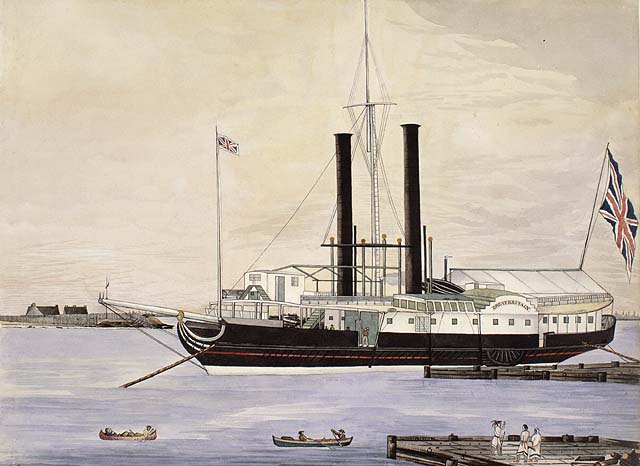 |
Travel by steamer...
From Prescott to York (Toronto), many of the Petworth immigrants travelled aboard the Great Britain, a 3,500 ton steamship with sail-assist. At 322 feet long, it was the largest vessel on the Great Lakes at that time. As many as 700 travelled aboard her at a time. At a distance of only 200 miles or so, this part of the trip would have taken some 24 to 30 hours.
John Stedman describes the trip from Prescott... "when we left Prescott for York, we crossed a lake, we was overtaken by a dreadful tempest: we was within 30 or 40 miles of York: we then was driven back on the shore, about 80 miles from York again."
Borne by their sponsors, the cost of the journey from Portsmouth, England, to York, Upper Canada, was expected to be 10£. for adults, 5£. for children under fourteen years, and infants under 12 months, free.
As a guideline, the 1832 Emigrants Handbook For Arrivals in Quebec included a description of the journey within Canada and its costs...
Having arranged all your business at Quebec, you will proceed without loss of time to Montreal, by steam-boat, on your route to Upper Canada. Two steam-boats ply daily to Montreal, 180 miles up the St. Lawrence, which is performed in 24 to 30 hours. The fare for deck passengers, is 7s. 6d. for adults,--children from 3-12 years pay half price, and under 3 free. These steam-boats belong to private individuals. Government is in no manner connected with them. At Cornwall, Prescott and By-Town (present-day Ottawa) you will find Government Agents who will advise you should you require it. Emigrants arriving at Quebec from the United Kingdom, and who are desirous of settling in Upper Canada, or Lower Canada, or of obtaining employment, are informed that all necessary information for their guidance may be obtained (gratis) on application at this Office, between the hours of 10 and 3 o'clock daily, Sundays excepted.
Routes, by the St. Lawrence and Lakes, to the principal places in Upper Canada, are as follow:
Quebec to Montreal, by steam-boats........................................................7s. 6d.
Montreal to Prescott, by Durham boats...................................................6s. 3d.
Prescott to York, Capital of Upper Canada, Hamilton and Niagara......40s. for 1st cabin, 20s. for 2nd cabin, 10s. for "deck".
Children travelled at a reduced price (about half), and infants generally travelled free.
Each deck passenger allowed 1 cwt. of baggage.
Dogs were charged for, at 2s. 6d. each.
Baggage was charged for, for each hundred pounds over the allowed weight (and in one instance of Montreal to Prescott, cost about half the fare of an adult).
Having arrived in York (present-day Toronto)...
So, here they are - all off the boat together in York (or the less grand dirty Little York as it was at times called), on the 23rd of June, 1832. The weather would likely be warm enough, and they had arrived in a young city, bustling with commerce and immigrant activity. There was work available, but lodging was expensive.
Joseph and his family were among the 52,000 who landed in Canada in 1832, the peak of immigration levels. Some 11,000 made it to York. The nearest unallocated land of significance was already fifty miles away in 1821, and had undoubtedly become farther away with each passing year. The population of York was just 4,000 in 1832, though it grew to be a city of 15,000 by 1842 (renamed Toronto in 1834) - obviously almost all of the immigrants simply passed through York to travel on to take possession of plots of land throughout the southern half of Ontario, or on to other destinations altogether.
These questions come to mind...
1) What exactly had they brought with them (cash, possessions, etc)?
Since the family had been sponsored, one can assume that they were unlikely to have had any significant cash or unessential possessions with them. If they had followed the guidelines laid out by the Petworth Society, they would have had clothing, bedding, kitchen utensils and household tools - not exceeding the 500 pounds per person permitted.
2) How exactly were they told what land they would get?
"After the emigrants arrived at York, they were forwarded to various places in the province, by direction of the Lt. Governor Sir J. Colborne, and either settled on land, or got immediate employment, at high wages."
"The principal situations in Upper Canada where arrangements are made for Locating Emigrants are in the Bathurst, Newcastle, Home and Western Districts. Indigent Emigrants, on condition of actual settlement, may obtain a Location on the following terms, viz: Fifty acres of land will be allotted to each head of a family, upon condition of paying at the rate of 5s. currency, per acre. The first payment of three pounds two shillings and sixpence is to be made at the expiration of three years, the remainder by annual instalments of an equal sum, with interest, commencing from the expiration of three years.
The Government will incur the expense of building a small Log House for the temporary accommodation of settlers on their respective Locations, and will afford some assistance towards opening roads to the lands proposed to be settled, but will make no advances in provisions or utensils, and the settlers must depend entirely upon their own resources for bringing their lands into cultivation."
3) What land would have been offered to them by the government at the time?
On May 21st, 1832, this timely notice was released by Peter Robinson, Commissioner of Crown Lands Office. It is highly likely that these are the lands offered to Joseph and his family.
"Notice is hereby given, that a portion of the Crown Lands in the Township of Oro, Medonte and Orillia, on the Lake Simcoe, in the Home District, will be exposed to Sale by Public Auction, at the upset price of Five Shillings, Currency, per Acre: and also, a portion of the Town Lots in the Town Plots of Kempenfeldt Bay and Roach's Point, at the upset price of Ten Pounds, currency, each, and upon the express condition of building a stone, brick or frame house, not less than twenty-four feet long and eighteen feet wide, to be completed within two years from the day of sale. The sale to take place in the Court-House in the Town of York, on the second day of July next, at ten o'clock a.m."
Of course, previously dispensed parcels of land were being sold, re-sold, and abandoned, so these parcels would have been available also.
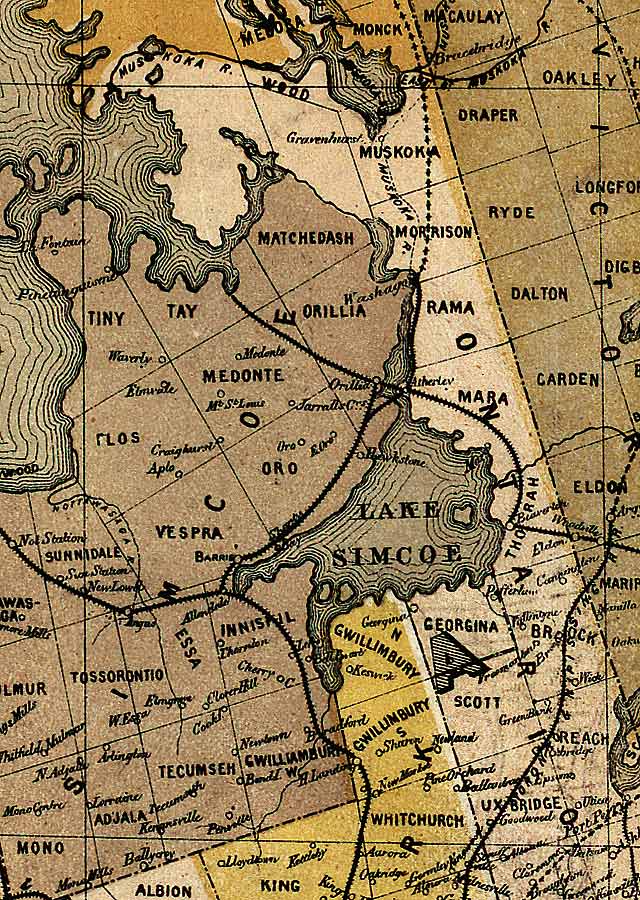 |
This map (albeit from 1871) shows the townships as they probably were when Joseph and his family arrived in Ontario.
Since York did not yet extend above Bloor and Yonge (about three miles from the lakeshore), 50 miles or so north would have meant almost to Barrie, Ontario. In that area can be found the townships of Mono, Adjala, Tecumseh, Mulmur, Tossorontio, Essa and Innisfil to the west of Lake Simcoe; Gwillimbury, Georgina and Scott to the southwest of the lake; and Nottawasaga, Sunnidale, Vespra, Oro, Flos, Medonte and Tiny townships to the northwest. All of these townships are referenced in later records of the family and their descendants, so it is likely that the family did go north somewhere into these townships initially.
The 1837 Toronto & Home District Directory shows only one Longhurst entry - for Mono Township, with no given name or lot number. If this is where some of the family settled, then the following newspaper article will lend some insight into those early days.
From the Orangeville Banner (February 11, 1909), page 3: "The following interesting narrative of the settlement of the Mono Centre district has been handed The Banner by a Mono subscriber, who is himself one of the township's early residents: -
Settlement in the neighborhood of Mono Centre commenced in the year 1834. Mr. Robert Large who arrived in that year took up his residence on the farm now occupied by Mr. Robert McCutcheon. His closest neighbors were in the vicinity of Mono Mills, eight or ten miles away.
Nearly the whole of the township was at that time a howling wilderness. There was scarcely any clearing, nor were there any trees cut except those along the lines of the government survey. The only road form Mono Mills north to 20 sideroad and it was a mere trace cut through the forest, just wide enough for a yoke of oxen and a jumper to travel along. The jumper was the vehicle must used in those times, although a wagon was used occasionally for the purpose of cadging provision and other necessaries to the settlers. Shortly after his arrival Mr. Large wrote to Messrs. Currry, Laidlaw and Turnbull telling them the best place to select their land. This they did at the Government Land Office at Ottawa on their way to Western Ontario. Mr. Curry settled on the e1/2 of lot 18, con. 3 E.H.S., Mr. Large being on the west half of the same lot. Mr. Laidlaw took up his residence on lot 19, cons. 3, E.H.S. and Mr. Turnbull on lot 19, con.2, E.H.S. The Curry, Laidlaw and Turnbull families came in during 1935. In the following year the little settlement was augmented by the Andrew Henry, John Still, Peter Stewart, Joseph Lundy, Partridge, Buchanan and Laverty families. Mr. Still and family - there were eight sons- settled on lot 22, con. 4, east. Mrs. Stewart and Mrs. Still were sisters and Mr. Still and family made their home at Stewart's until they got their house built. Before the summer was over the little community was east into gloom by the death of Mrs. Still, which occurred before her home was completed and ready for occupation. She left a baby child, which was reared by Mrs. Stewart. Mr. Stewart, who was a blacksmith by trade, had brought a set of tools with him and erected a small shop on Mr. Laidlaw's farm, where he worked at his trade until he was able to build a more commodious smithy on his own farm, lot 20, con. 4, east. Mr. Laidlaw had the misfortune to meet with a very serious ---- they were unable to save anything. Everything they owned, including some money, was consumed, except the clothes they were wearing and their yoke of oxen and jumper. This I think was the first serious fire in Mono.
The first schoolhouse was built on the parcel of land now occupied by the Mono Centre burying ground. Mr. John Phoenix was the first teacher. He lived in the school during the week and boarded himself. By some accident the school was destroyed by fire and it was necessary to erect another seat of learning. The southeast corner of lot 18, con. 2, east was selected as the site. The next teacher came from Toronto and who had a wooden leg. He in turn was succeeded by Mr. Daniel McNaughton. Mr. James Still and family joined the little community in 1840, settling on lot 22, con.4, east. The family consisted of two sons and two daughters. The first meeting for the purpose of nominating and electing a township council was held in Mr. Thomas Buchannan's house. It was given the name of town m meeting. Nominations and election took place at one time and generally lasted two days. There were no ballots in those days, the electors making their decision by a show of hands, for each of the candidates. Mr. Michael Island was the first reeve of the newly organized township. The first funeral was that of Mrs. John Still in 1836. She was buried on the west half of lot 13, con. 5 east, which was at that time clergy reserve land. The remains were afterwards removed to Mono Centre burying ground.
It is interesting to note that in the year 1836 three veterans of the Battle of Waterloo took up their homes in the new settlement. They were Messrs. Glover, Milvogue and Richard Wardrope."
4) How did they get to the land granted, or sold, to them?
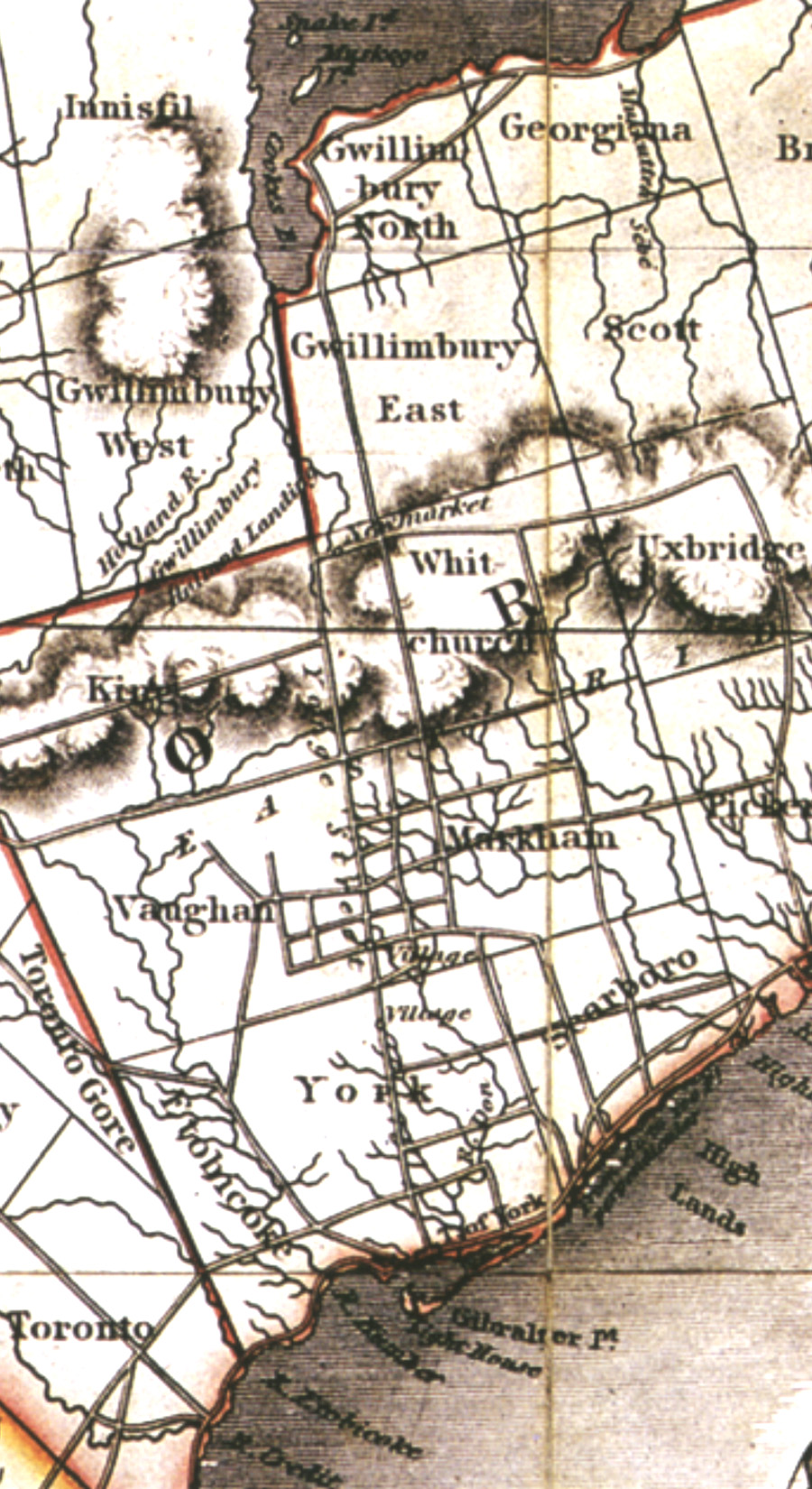 |
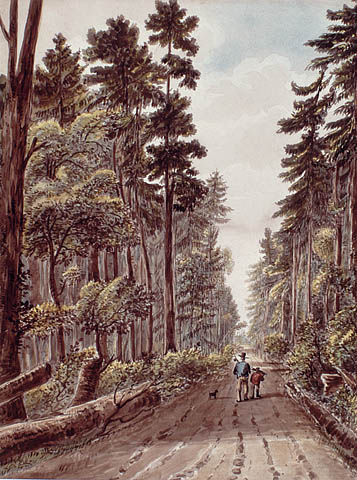 |
This early map shows Yonge Street, leading north from York towards Lake Simcoe and beyond. Yonge Street would have likely been the main route for pioneers to travel north and south in the province. Ontario roads are laid out primarily in a convenient grid pattern of lines and concessions. Travelling from York (Toronto) to points north would likely have taken place on Yonge Street or on one of the other few major north-south routes. Many of the Longhurst ancestors in the 1800's lived no more than 20 miles east or west of Yonge Street, between Lake Ontario and Lake Simcoe. Those who lived west of Lake Simcoe would be perhaps 30 miles from Yonge Street. Those who lived above Lake Simcoe would also know Yonge Street (or Highway 11) as a major thoroughfare.
The artist's depiction of the road from Kingston to York in 1830 shown here gives one an idea of what it might have been like to travel in Ontario in that era.
A team of oxen pulling a "jumper" was a common means of moving possessions, goods, and materials. Two long poles fashioned together would be loaded and dragged along by the oxen. Wagons would be used if available. The oxen could later be used for many other farming activities, like pulling a plow, pulling out stumps, or moving logs from their place of harvest.
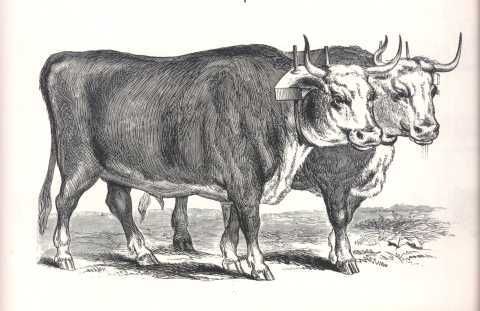 |
ChatGPT: Pioneer Modes of Travel
"Pioneers in Upper Canada (now Ontario) from the early 1800s to 1870 relied on a variety of transportation methods, depending on the distance, terrain, and resources available.
By Foot: Walking was the most basic and essential mode of travel. Many pioneers walked long distances to settle or visit family. Early roads, if any, were often rough and unpaved.
By Horse: Horses were commonly used for transport, whether for riding or pulling carts and wagons. A horse was vital for carrying goods over longer distances and provided a quicker means of travel.
By Cart or Wagon: Settlers used carts and wagons to carry goods and people. These were drawn by oxen, horses, or mules and were essential for transporting heavy loads through the rough wilderness.
By Ship or Boat: Waterways played a significant role in early travel. Pioneers used boats, canoes, and sometimes larger ships to move along the Great Lakes, St. Lawrence River, and other water routes. This was particularly crucial for reaching remote settlements.
By Rail: Railroads started to appear later in the 19th century. The first railway in Canada was the Champlain and St. Lawrence Railroad (1836), but rail travel became truly transformative after the completion of the Grand Trunk Railway in the 1850s.
Communities typically sprouted up around a day's travel by foot or horseback, often about 30 miles apart. This allowed settlers to travel to nearby towns for trade, church, and social activities, which helped form the foundation for the network of towns that would shape the country."
5) Once on their land, what was early life like?
To comply with the terms of the Government pertaining to receiving free land...
"Five Acres to be cleared to every hundred acres granted, a Log-house, sixteen feet by twenty, roofed and finished. Every lot of two-hundred acres must have a Road cut at each end, 33 feet broad; but a person getting only half a Lot, (a hundred acres) cuts his road only at one end. The Clear Land must be fenced, the Logs and Brushwood burned, and the ground fitted for the harrow."
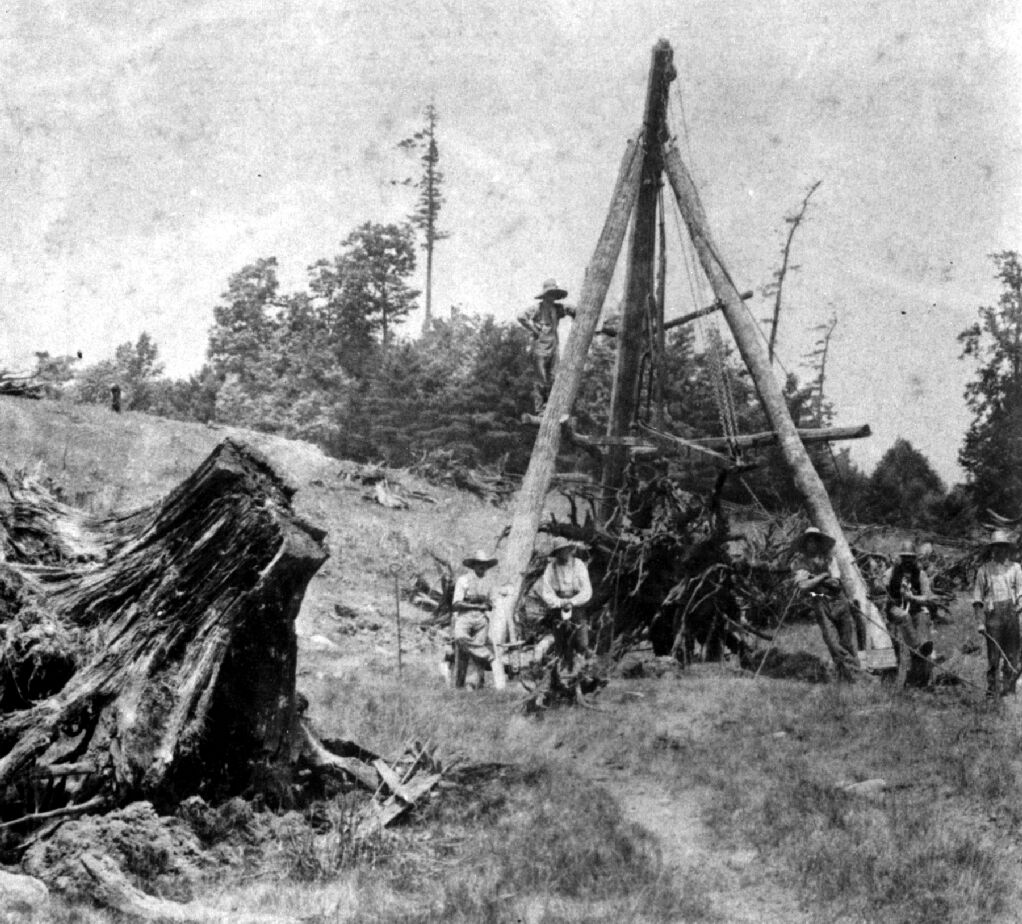 |
Clearing the land was the first task, though it was recommended that only enough land be cleared as was needed for sustenance. Clearing the rest of the land would come later.
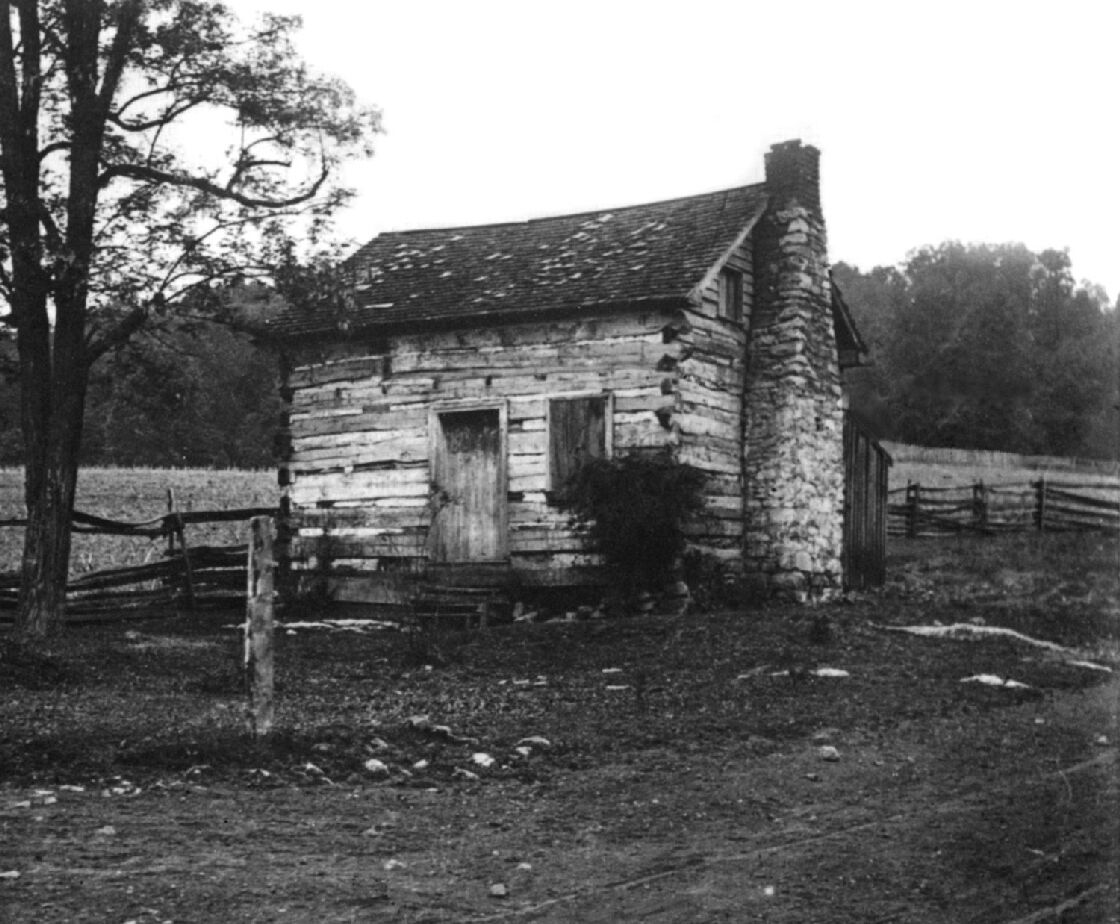 |
Putting up a log cabin, of at least the required size - 16' x 20', would begin immediately. An early start on a garden and fencing would be next. Accumulating firewood and supplies for an Ontario winter would be somewhat urgent, too, as winter would be upon them in just six short months from the first day of spring.
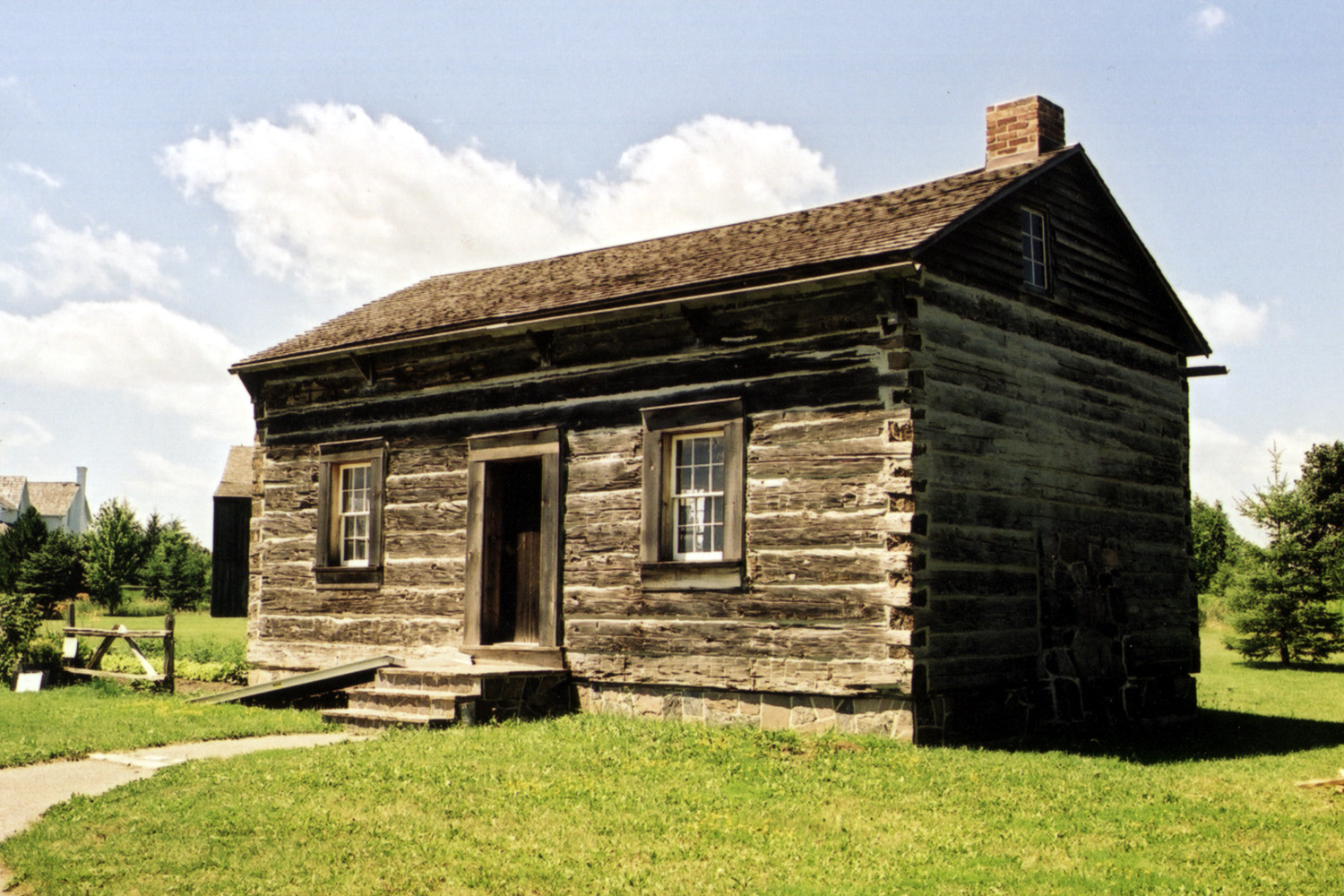 |
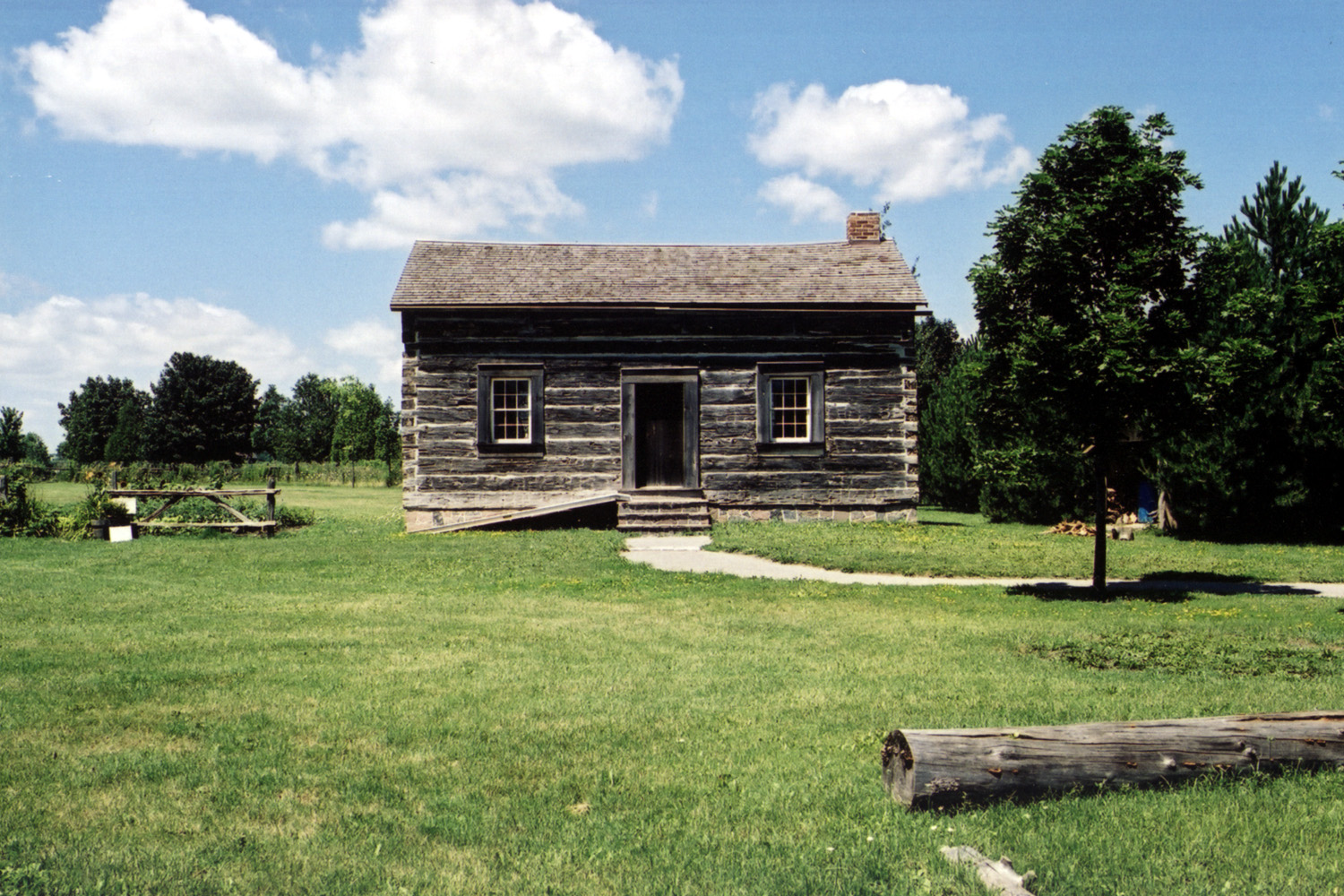 |
These two photos are of the Maxwell log cabin on display at the Markham Museum and Historic Village. Somewhat larger, but of similar construction, it is made of notched logs with a mixture of mud and moss to fill the cracks. Early on, oiled paper would have substituted for glass in windows.
6) Where did they get their supplies?
Initially, there would have been few towns and stores to provide the needed supplies. Trips to populated areas must have taken place periodically, and may have been shared excursions with neighbours in the better weather of summer when crops were simply growing with less care needed. Since people are generally gregarious and do not like isolation, knowing the neighbours would be a certainty and trading with them may have been common.
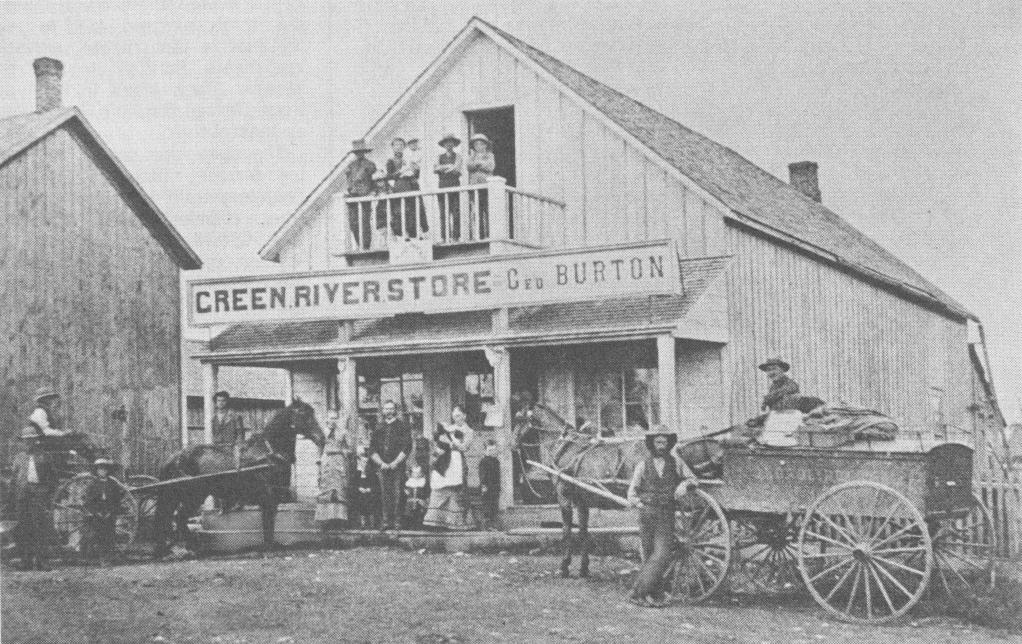 |
This photo of a store in Green River, Ontario (near Pickering) was taken c1880. A wooden structure on an unpaved street would be quite common in that era, as would a horse pulling a wagon. (The store owner, George Burton, is believed to be related to "the other" Thomas Burton.)
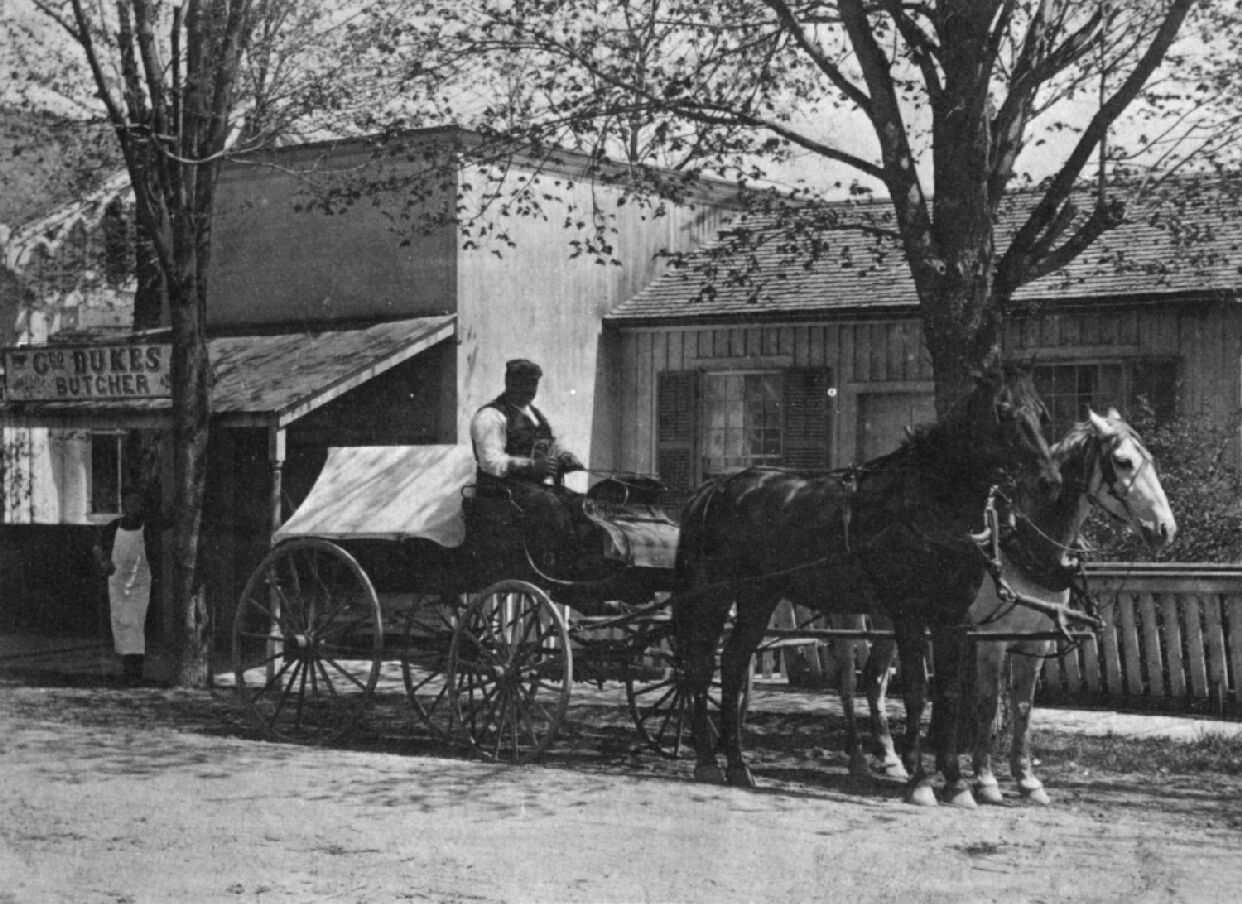 |
This photo of a butcher shop appears to have been taken in a more developed area. Mature trees and several buildings together suggest this. There were several Longhursts involved in the meat business, and Archibald Walter Longhurst Jr. was one of them. It is believed that he owned his own store (which may well have looked just like this), and his son Archibald Thomas was a deliverer of their product when he met his wife-to-be. Other Longhursts worked for meat-packers at times in their lives.
7) What did the pioneers grow or raise, and what market did they have for their produce?
Farming was by far the primary occupation of the citizens of Ontario for most of the 19th century. It was a family affair - with husband and wife sharing the workload, and children helping out as early as age five.
ChatGPT: the Business of Farming
"Pioneer farms in Upper Canada and Canada West primarily produced staple crops such as wheat, oats, corn, and barley, along with vegetables like potatoes, cabbage, and carrots. Livestock, including cattle, sheep, and pigs, were also common, providing meat, milk, wool, and other products. These farmers were mostly self-sufficient, growing what they needed to survive and trading surplus goods with their neighbors. The ability to produce food for personal consumption as well as for market sale was vital for survival and prosperity, and it shaped the local economy in both rural and urban areas.
Farmers sold their produce at local markets, where their goods were often purchased by retailers who would then resell them in towns or cities. These markets were hubs of commerce, providing farmers with a place to make transactions and build connections."
As farming communities grew, so did the need for more efficient production. Over time, animal-drawn vehicles such as carts and plows were replaced by machinery, which began to arrive in Ontario in the mid-19th century. The introduction of steam-powered engines and later, gas-powered tractors, reduced the reliance on horses, oxen, and other draft animals. These innovations allowed farmers to cultivate larger plots of land more quickly and with less labor, transforming farming into a more industrialized operation. Though machinery was initially expensive, it increasingly became a standard part of farm life as technology advanced, improving both productivity and the way goods were transported to market."
8) how else did pioneers earn their living?
Tradesmen and laborers were welcomed in pioneer Ontario. Carpenters, sawyers, coopers, bricklayers, metalworkers, workers in mills, factories, at the docks, on the roads, driving vehicles, for the railroads; teachers, storeowners and the retail industry; enterprising businesmen, salary- or wage-paid, there were plenty of jobs off the farm.
ChatGPT: Pay and Urbanization
"For many skilled tradesmen, wages could be higher than those of farmers, who were dependent on the seasons and crops. For example, carpenters or mill workers in towns often had more consistent wages, though hours could be longer depending on the workload. However, the pay in these trades often didn't necessarily outstrip farming in the long run, but these workers were less vulnerable to crop failure and could rely on regular hours, unlike farmers who had to contend with unpredictable weather. As industrial work became more common, more people moved into urban areas, contributing to the rise of towns and cities. This shift towards urbanization was particularly true for those working in factories or on the railroads."
ChatGPT: Working Women in Pioneer Ontario
"A woman could work and supplement a family's income or simply support herself. Domestic servants, teachers, seamstresses, milliners, nurses and midwives, farm workers – women's roles were traditionally confined to the home, but the expanding economy, including factory work, saw women moving into non-traditional roles. While factory jobs were often poorly paid, the work gave women more independence and the opportunity to support themselves financially. By the late 19th century, women increasingly worked in urban areas, contributing to the rise of a middle class that could afford domestic help or services. Women's growing presence in the workforce also contributed to the early stages of the women’s rights movement, as they began to demand more rights in terms of wages, working conditions, and the right to vote."
9) Was there an opportunity for the children to receive an education?
Education for the masses amounted to one-room schoolhouses with a wood stove for heat in the winter. Reading, writing and arithmetic, with some history and geography, were the subjects. Children supplied their own slates, paper, ink and quill pens. (Schools would receive their first blackboards around 1860). Children brought their own lunches, or were fed from a "community" stew. Children would attend until the time came that they were ready for, or were needed for, adult work.
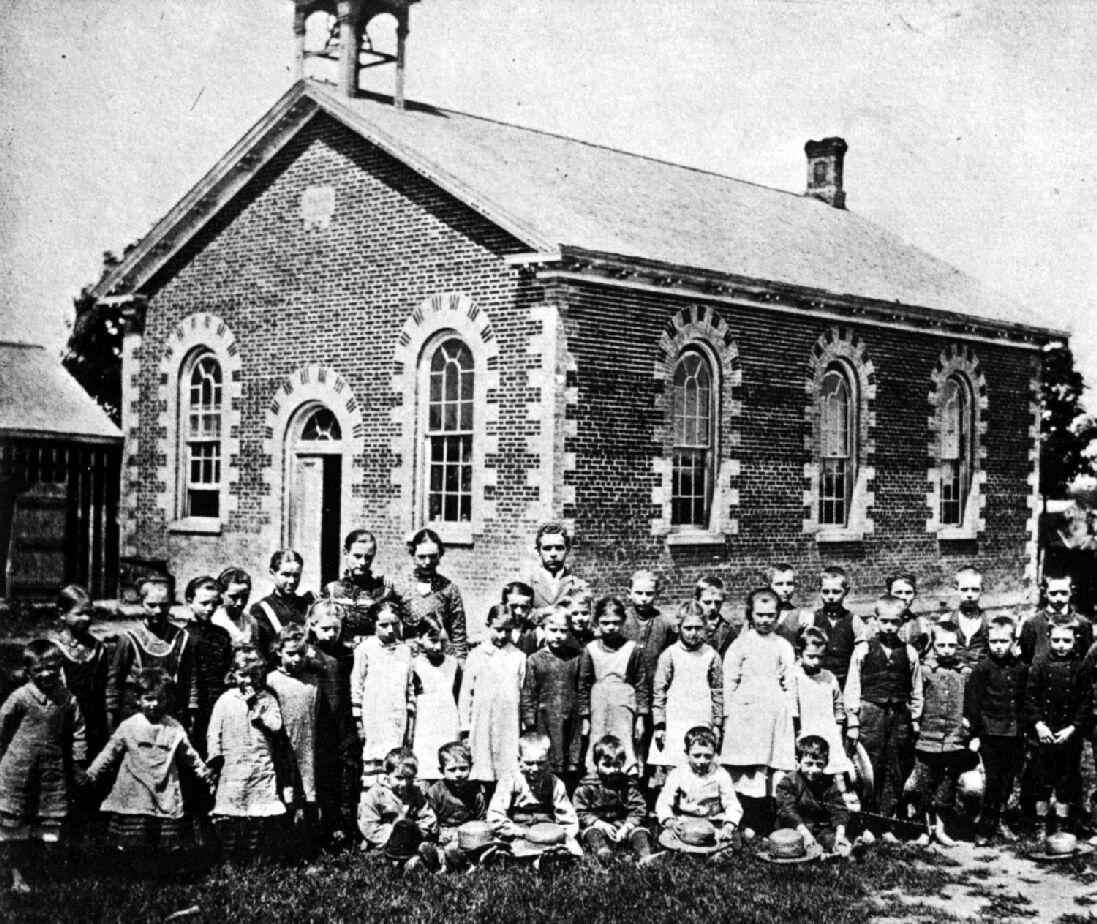 |
A sense of the times comes from these Rules for Teachers...
- Teachers each day will fill lamps, clean chimneys.
- Each teacher will bring a bucket of water and a scuttle of coal for the day's session.
- Men teachers may take one evening each week for courting purposes or two evenings a week if they go to church regularly.
- After ten hours in school, the teacher may spend the remaining time reading the Bible or other good books.
- Women teachers who marry or engage in unseemly conduct will be dismissed.
- Every teacher should lay aside from each pay a goodly sum of earnings for his benefit during his declining years so that he will not become a burden on society.
- Any teacher who smokes, uses liquor in any form, frequents pool or public halls, or gets shaves in a barber shop will give good reason to suspect his worth, intention and honesty.
- Any teacher who performs his labour faithfully and without fault for five years will be given an increase of 25 cents per week in his pay, providing the Board of Education approves.
An act passed in 1816 by the Government of Upper Canada dealt with school matters. When a community wished to establish a school, three trustees would be appointed who would hire a teacher of their liking, and be authorized to pay a teacher's annual salary of not more than £30. In 1844, Dr. Egerton Ryerson was appointed to supervise schools in Canada West. In 1849, municipalities were empowered to levy taxes for school purposes. By the 1870's, all school expenses were raised by taxation and school attendance was compulsory. Initially, Ontario children between the ages of seven and thirteen had to attend at least one hundred days of school in every year.
10) What about church?
In the lesser populated areas, people would gather at someone's home for a church service. When available, the service may be performed by a circuit preacher. As the communities grew larger, a church was often the first communal building erected, and a resident reverend or priest may be assigned. Since people of common backgrounds tended to settle together, there may be the need for only one denomination until the community is well on its way to becoming a town.
All were expected to attend, though which church was entirely the choice of the individual.
11) Were there doctors and medicine available?
ChatGPT: Strides in Medicine and Medical Practice
"Between the 1830s and 1900, advancements in medicine were gradual but transformative. Early on, medical care was rudimentary, with doctors relying on remedies like herbal treatments or bloodletting. Surgery was dangerous, often performed at home or by traveling physicians, and infections were common due to a lack of understanding about germs.
By the mid-century, pioneers began to see improvements. Anesthesia, introduced in the 1840s, made surgery less excruciating, and by the 1860s, antiseptics like carbolic acid helped reduce infections. Germ theory also became more widely accepted, leading to better hygiene practices. Vaccines, particularly for smallpox, became more common, offering hope against devastating outbreaks.
Despite these advancements, many pioneers still relied on home remedies and midwives, especially in rural areas where doctors were scarce. The growing availability of trained nurses and the development of medical schools improved care in towns, but for pioneers, accessing these resources often depended on location, weather, and the availability of transportation. Medicine was improving, but for most settlers, it still involved a mix of tradition and emerging science."
12) Were family members able to communicate with each other?
ChatGPT: The Postal System
"Pioneers were often isolated, and communication with family members or business partners back home was essential. Whether sending news of births, deaths, marriages, or requests for goods, written letters were one of the only ways to connect with the outside world. The postal system allowed for vital communication, even though it could be costly and slow.
In a community, the social need for communication often included visiting with neighbors for news or practical information about new routes, crops, or land development. Mail would bring business correspondence, legal documents, or family updates, which people relied on heavily, particularly in times of conflict or distress. Letters became a primary tool for keeping in touch, especially for those living far from cities.
As settlements grew and more people arrived, the postal service became crucial for facilitating the exchange of information and goods. It supported social connections, enabling letters to carry messages of friendship and news over great distances. Though not without difficulty, the system eventually matured into a reliable mechanism that allowed for clearer, faster communication— though still requiring patience for those who waited for a letter to arrive."
"A functioning postal system was critical to communication, especially for isolated communities. By the mid-1800s, the Post Office Act of 1851 formally established the Canadian postal system.
In the early years, the recipient typically paid for postage, which was calculated based on the weight and distance the mail traveled. Postage was often high, and the system relied on the network of roads and riverways to deliver letters. This system evolved into a more organized service with standard rates, and Canada's first postage stamp was issued in 1851. Known as the "Three Penny Beaver", it was a symbol of Canada's commitment to modernizing communications.
At this point, mail was carried by post riders or stagecoaches. These vehicles and riders would follow regular routes, often taking days or weeks to complete their journeys, depending on the distance. In rural areas, mail would be left at local general stores or picked up at the nearest post office, which might have been a day's travel away for many settlers.
By the time the railroad extended across the country, railway post offices allowed for faster and more reliable delivery. Trains and ships were also employed for delivering mail over long distances."
Tell-a-gram (about a new grandchild, perhaps)...
ChatGPT: the Telegraph
"The telegraph, which made telegrams possible, began in Ontario in the early 19th century, with the first successful telegraph line between Toronto and Hamilton completed in 1851. The arrival of the telegraph significantly improved communication, especially along railways, where lines were often constructed to match the expanding train routes. By the 1860s, telegraph offices had opened in cities and towns across the province, and telegraphy became essential for business, government, and personal communication.
The rates for sending telegrams varied depending on the distance and the number of words, but they were generally expensive for most families. Telegrams were often used for urgent news, such as births, deaths, or important announcements, and their arrival was eagerly awaited. By the 1870s, telegraph lines had expanded, reaching more remote areas, although it wasn't as widespread as the postal system."
With a few exceptions, electric power and telephone service in rural Ontario wouldn't really arrive until around 1920.
Motorized vehicles, steam, electric and gas-powered carriages (cars) and trucks, would come first.
What were the future prospects of pioneers in Ontario?
Excellent. If there were absences in life, these would be in medicine, and in security in old age.
ChatGPT: Economic Prospects for Pioneers in Ontario
"Economic prospects for pioneers in Ontario were a mix of challenges and opportunities. Settlers often started with subsistence farming, clearing forested land to grow crops and raise livestock. Over time, as infrastructure like roads, railways, and markets developed, farmers could produce surplus goods to sell locally or export, creating opportunities for modest prosperity.
Pioneers faced significant hardships, including backbreaking labor, unpredictable weather, and limited access to tools or markets. However, as communities grew and trade expanded, prospects improved. Tradespeople like blacksmiths, carpenters, and millers found work supporting agricultural and village life. Women often contributed by managing households, producing textiles, or selling goods like butter and eggs.
For some, economic success meant accumulating land, improving yields with new equipment, or transitioning to specialized farming. Others shifted to non-agricultural jobs in growing towns or industries like lumber, rail, or manufacturing, offering steady wages and shorter hours. Despite the risks and hard work, pioneers laid the foundation for Ontario's economic development."
What happened to the original family members and their families?
After having arrived together in 1832, the family began to move apart in the province and elsewhere. Of those family members, here is what is known or surmised.
Joseph Longhurst and wife Sarah Haysman...
The only detail at present as to where they settled is the stated fact that they were 20 miles away from son George and his wife Rebecca, but it is not yet known where George and Rebecca settled initially either.
Joseph was a carpenter by trade, so he would have been readily employable when not working on his own farm. Joseph would have been 45 years old when he came to Canada. (Sarah would have been 46.)
The 1851 census for Canada West, York County, York Township, shows Jos. (age 62, a farmer) and Sarah "Longert" (age 65, "age next birthday" rule), with "Fred" (son Frederick, sawyer) and "M A" (Frederick's wife of two years, Mary Anne). All are a part of the Church of England. Since the census record lines appear together, with Frederick, then Mary Anne, then Joseph and Sarah, the property may well have been Frederick's, and the aged parents were living with them. Or, the newlyweds were living with the parents. (Usually, though, the first line is for the head of the household.)
Although it is not presently known when Joseph and Sarah came to live in Perth County (near Stratford), it would make sense that it had to do with Caroline's husband George Parsons M.D. having a farm there. The Longhursts must have lived happily in the area, for they are buried there by preference. For this to have happened, they were likely living in the area prior to Sarah's death in 1863.
The 1861 and the 1871 Censuses report aged widower Joseph to be living on the farm of George Parsons. (See more info below, in the information about daughter Caroline.)
Joseph died September 7, 1877, at the age of 90. Sarah (Haysman) died in 1863 (?, not on the 1861 census with husband Joseph), at the age of 77. Both died in Fullarton Township, Perth County, Ontario, and are buried in Avonbank Presbyterian Church Cemetery, Fullarton Township, Perth County, Ontario.
The link above leads to several photos and directions to the cemetery, from a trip made in 2004.
This photo is of the gravestone.
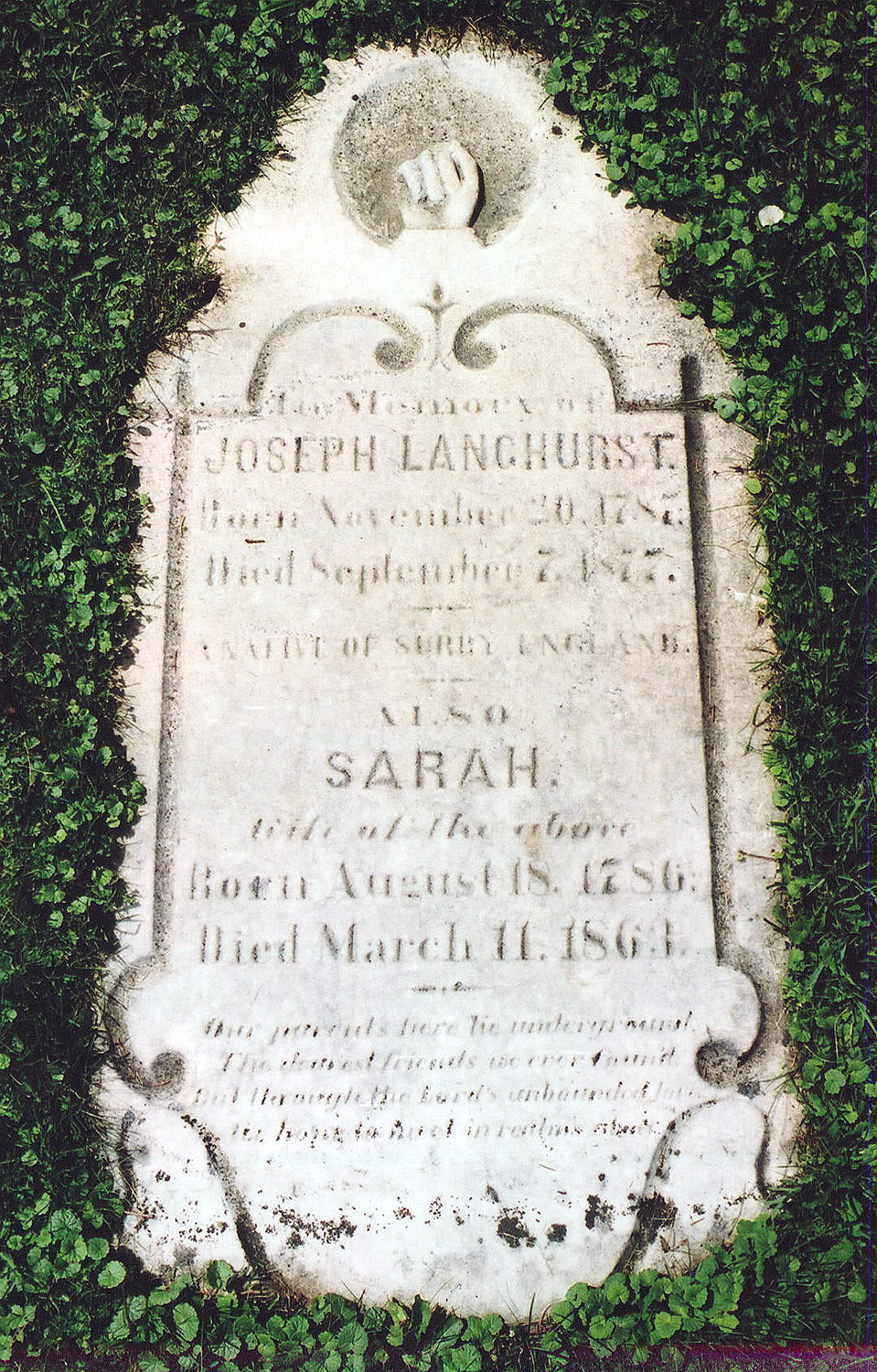 |
____________
Son George and wife Rebecca (Weller)...
George Longhurst and Rebecca Weller married on July 4, 1831, in Dorking Capel Surrey England. Their first daughter was born in England in November of 1831. She would be not quite one year old when they came to Canada.
In her letter, Rebecca states "Father and mother and the younger brothers and sisters are living 20 miles from us."
In this same letter, Rebecca also states "...we have all plenty of work. George and Charles have built two houses, and they have got a driving shade 50 feet square, and a genteel cottage to build this winter, and if George has his health this winter we shall be able to purchase a hundred acres of land in the spring, which we have already looked out."
George would have been 23 years old in 1832, and brother Charles would have been 21. Rebecca was 24 at the time.
The way Rebecca states that George and Charles "have built two houses", indicates that they were probably quite near each other, and perhaps on the same plot of land.
If George and Rebecca had "already looked out" a one-hundred acre parcel of land for purchase in 1833, they were probably already near, or outside, that 50 mile radius of York (the city) - where the available land was.
In c1866, George and Rebecca's first-born son married the second-born daughter of brother Charles and wife Martha - another indication that these two families continued to associate with each other and were probably not living far apart.
A son born in 1837 in Mono Township (one township south of Mulmur) and other children born through 1848 suggest that the family settled in Mono Township during that time and moved to Mulmur Township before son Albert was born in 1853. Mentions of Scott Township and East Gwillimbury for their children leads one to think that the children settled below Lake Simcoe.
George and wife Rebecca were in Mulmur Township, with all members of their family, in 1861. George died in 1869, in Mulmur Township, Ontario, Canada. Rebecca died Oct. 27, 1888 in Watt Township, District Muskoka, Ontario. Daughter Christiana died at age 60, in the same place as her mother - indicating that she may have lived with, or near, her parents much of her life.
____________
Son Charles...
In Rebecca's letter noted above, Charles and George must have lived close together, at least in the beginning.
Charles Longhurst had married Martha Inkerman in 1832, when he was 21 and Martha was 19. It is presently not known whether the marriage took place in England or Canada. Their first child was born in 1836, with their twelfth child being born in 1860.
As with brother George and Rebecca, there are no concrete geographical references as to their whereabouts during these years, but similar mentions of Scott Township and East Gwillimbury for their children leads one to think that they also settled below Lake Simcoe.
The census of 1881 in East Gwillimbury records Charles as being 70 years old, living with his daughter Sarah Anne and her husband Weller Longhurst (son of George and Rebecca). There is no mention of Charles' wife Martha in the census.
Charles died in Toronto, Ontario, in 1892. Martha Inkerman died four years later, though it is not noted where.
____________
Son John...
Just nineteen years old when the family emigrated from England, there does not seem to be any record of his movements or actions in Canada. No marriage records, no records for children, and no record of death.
It is plausible that John left Ontario, in which case there may be American records. Other members of the Longhurst family had moved to the U.S., like John's brother Jesse Isaac (to Michigan), making this believeable. James and family lived briefly in the U.S. also.
____________
Son James...
James Longhurst married Flora Macdonald in 1837. Their first daughter was born in King Township, York County, in 1838. Their second daughter was born in Buffalo, New York, in 1840. Their third daughter was born in Buffalo, in 1842. Their fourth daughter was born in Vaughan Township, York County, in 1843. These events tell us that James and his family went south into the U.S. to live for perhaps three years, after which they returned to Ontario. What prompted the journey or the return would likely be their quest for a more prosperous life.
Their next three children, born over the next seven years, were all born in King Township, York County. This places the family in King Township until at least 1850.
All seven children were baptized on October 19, 1851, by Matthew Nichols, in King Township, York County, five weeks after the last child was born. James was recorded in the baptismal register of his children, taken by the Markham Circuit Primitive Methodists, as being a "labourer".
In the 1851 census report for York County, King Township, much information is confirmed. James appears with wife Flora, and children Esther, Sarah, Mary Ann, Flora, Christanna, Archy, and James. Religion is noted as Methodist for all. James is a sawyer, age 36, born in England. Flora is 38, born in Scotland. The second and third children were born in the United States, while the others were born in Canada. Likely year of return is 1844, per a death record for daughter Mary Anne.
James was in Mulmur Township, in 1861, with all his family (their eldest child was Esther, aged 22), when the census for that year was taken.
James was in South Simcoe, District 41, according to the 1871 census. At age 55, James was with Flora (age 58), and two sons (Archibald, age 22, and James, age 20). The sub-district appears to read "G", for Innisfil. All are noted as being farmers.
James and Flora appear on the 1881 census for District 138, Innisfil, Township.
James died __________ of _____________ and is buried in Mulmur Episcopal Cemetery, Ontario. Flora died in 1899, not far away in Innisfil, Ontario.
____________
Daughter Anne...
Anne Longhurst was just 13 when her family emigrated to Canada. As the eldest daughter, her life, until her marriage at age 25, was probably filled with domestic duties. Anne married a man named Peter Lawrence. Details of their life together or any resulting progeny are, as of this writing, unknown. Anne died in 1898.
____________
Son Frederick...
Frederick was just eleven years old in 1832 while making the trip from England. Frederick married Mary Anne Eleanor in 1849.
A census taken in 1851 shows Frederick and Mary Anne living in York County, York Township. The same census page shows Joseph and Sarah, perhaps on the same, or adjacent, properties. "Fred Longert" is shown as being a sawyer, born in England, part of the Church of England, age 30.
Frederick died in 1899, in Toronto, Ontario, of Bright's disease. His record of death notes his occupation as being a farmer.
Son Jesse...
The youngest son of Joseph and Sarah Longhurst, Jesse Isaac Longhurst must have been the adventurous one, for, in 1848, at the age of 24, Jesse was married in Chicago, Illinois to Mary Hoskins.
Jesse had eight children from this marriage, but his third child John Jesse was born in Toronto, so he and his family must have all come back to Canada within five years of Jesse's leaving, at least for a time.
After his wife Mary died in 1866, Jesse re-married, in Stratford, Ontario (near where his parents were living at the time, on Jesse's uncle George Parson's farm), to Sarah McMannie from West Gwillimbury, Ontario. Jesse's address at this time (1869) was recorded as being Chicago, so he may have been thinking of returning to live, but hadn't quite yet.
Jesse had another two children from this second marriage, but both died in their infancy. The place of death for the second child is Parkhill, Ontario - northwest of Stratford, nearing Lake Huron. It is thus likely that the family was in Parkhill in the year 1876.
Geographical references for Jesse's descendants are for places like Parkhill, Stratford, London, and St. Mary's, Ontario, which are all within about a modern 90-minute drive from each other, in what is known today as southwestern Ontario.
Jesse Isaac Longhurst died in April 15, 1891. He was buried in Detroit, Michigan. When he left Canada for the U.S. a second time is not known. Of his eight children with Mary Hoskins, three are known to have died in Michigan in the 1920's (while there is no location known at present for the deaths of the others). It is most likely that Jesse was with the family of his son John Jesse when he died at the age of 67.
The places in Michigan referenced (Saginaw, Albion, Detroit) are all within a modern hour's drive of Detroit, Michigan, which is just across the river from Windsor, Ontario, which in turn is about a modern two-and-a-half-hour's drive from Stratford, Ontario.
____________
Daughter Caroline...
In 1845, at the age of 18, Caroline married George Parsons M.D., age 37. Both had been born in England.
Caroline and George had five children.
The 1851 census entry for the family. George, Caroline, unknown Parsons 15-year-old (born in Canada, previous marriage? cause of first wife's death?) and Jabez (age 7).
The 1861 census reports widower Joseph Longhurst (Caroline's father) to be 74 years old, living on the farm of George Parsons, part lot 1, concession 11, of Fullarton Township, Perth County.
The 1871 Census reports widower Joseph Longhurst (Caroline's father) to be 83 years old, living on the farm of George Parsons, part lot 1, concession 11, of Fullarton Township, Perth County.
George Parsons died in 1869, at the age of 61, and was buried in the plot next to Caroline's mother. Caroline died in Toronto, in 1896, at the age of 69. She was buried with her husband, beside her mother and father. This would lead one to believe that the strongest family tie was between her parents and their youngest (living) child.
____________
Daughter Hester...
Hester had died at sea on the voyage over, and was buried at sea, so there is nothing to speak of as far as details of a life in Ontario.
Following the Petworth Emigration of 1832...
Joseph's son George Longhurst had married Rebecca Weller in England just months before the Longhurst family emigrated. Rebecca wrote of their journey to Canada to her mother in England. Rebecca's letter home was included in the "Letters From The Dorking Emigrants (who went to Upper Canada, in the spring of 1832) that were published, in London, in January 1833 with a letter from Charles Barclay of Bury Hill, Dorking.
Charles' letter addressed "To The Inhabitants of Dorking" begins... "Having introduced the plan for assisting persons from this parish to emigrate to Upper Canada, and having taken an active part in carrying it into effect, it gives me great gratification to publish the following letters, from some of the individuals who were sent out by your Association, during the last Spring."
Charles goes on to say... "The perusal of these letters will satisfy every unprejudiced mind that industrious persons, with or without small capitals, have a fair prospect of maintaining themselves and their families in comfort and independence by settling in Upper Canada. The idle and the dissolute will suffer the same privations and the same punishments there as in their own country. There is no provision for them. Every man must earn his subsistence by the labour of his hands.
I have no hesitation in giving the preference to this colony. The climate is very similar to our own, and the emigrant upon his arrival there will find himself surrounded by his fellow countrymen, engaged in similar objects, willing and able to give him both their advice and assistance. The expense of the passage is much lower than to any other Colony, and the voyage shorter and less harassing. As a national object it demands our preference, when we consider the importance of creating a strong and powerful barrier on this boundary of the United States, by the establishment of a numerous and thriving population."
Here are excerpts from a few letters from some of those who also made the journey...
From William Cooper, late of Burton, Sussex.
Adelaide, Upper Canada, July 28th. 1832.
Dear father and mother, brothers and sisters, I hope this will find you in good health, as it leaves me at present. I have been very well ever since I left England: we were seven weeks coming to Montreal, and five weeks more coming up to Kettle Creek. I have got 100 acres of land, at 2 dollars per acre, and one fourth to be paid for at the end of 3 years, and the rest in 3 years more. In English money, it comes to £41. 13s. 4d. in all. Tell my brother James I saw Richard Carter and his wife at Little York: they are doing very well, and said this would be a good opportunity for them to have come out to this country. I should like for all my brothers to come here; for here is plenty of work, and no doubt but we shall do very well after next harvest. Edward Boxall, and his wife, and Wm. Phillips from Merston, and we, have built us a Shantee, and lives and works altogether on our own land. We have got above 2 acres cleared, and shall sow 6 or 7 acres of wheat this autumn, and more in the spring. Dear father, I should like to have a malt mill, and a few pounds of thread, and above all things, a Newfoundland dog for myself; and take this letter to Merston, to Phillips' father, and tell him to be sure to bring him a dog, to catch the deer, and tell you what time of the year they means to come out; so that you may all come together. Answer this as soon as you receive it. I have to tell wheat is now selling, at 1 dollar a bushel; beef at 2½d. per pound; and mutton the same; and pork 4d. per pound in English money. Spirits is very cheap here. Farmers' men gets from 3 to 12 dollars a month, and board and lodgings, and washing and mending.
I have no more to say at present, so I must conclude, with my kind love to you all. I remain your dutiful son, William Cooper.
______________________________________
From George Hill, a labourer, late of Sullington, Sussex.
Ancaster, August 5th, 1832.
We were six days coming up from Montreal to Prescott, which was a very tedious journey. The boats are drawn up the rapids in some bad places, with 8 or 10 yoke of oxen. We have been here 5 weeks: I like the country here very much, but my wife don't seem to be quite so well contented yet. I got work the first day I was here, and have had plenty of work ever since. I got six shillings per day (New York currency) which is 3s. 9d. English money, and be boarded. Farmers and labourers all sit at one table here. We get 5s. per day, English money, and be boarded. I don't wish to persuade any one to come over, for they must expect to see a good many hardships; but I know that a poor man can do a great deal better here than he can at home: he is sure to get plenty of work, if he is steady, and can live cheaper. Puddock and me have rented a very good house at £1 per month, English money. I have bought a cow for £5, and a young sow for 12s. 6d. We work here from sunrise to sunset; but we don't work so hard as we do at home. We rest through the day very often: they are not particular here about losing a little time, as they are at home. Jane (aged 12 years) is out at service for a year, at 10s. per month, English money. George (aged 10 years) is with a Mr. Gabriel Gurnett (late of Horsham, Sussex) of Horsham, a saddler. Dear father and mother, we left you almost broken-hearted, but you may be satisfied that we have bettered our condition by coming here.
______________________________________
From William Spencer, late of Linchmere, Surrey.
September 16th. 1832.
Dear Father and Mother, Brothers, and Sisters, We arrived safe in York in Upper Canada. We came further up the country, about 30 miles, and there we went to work on the road, for 3s. 3d. per day: we were staying with Mr. Jacob Truller; and was enjoying a good state of health till the 22nd August: my dear wife was taken ill with typhus fever, and she departed this life on the 7th. of September: she was attended with all the neighbours; and we have found them very kind, much kinder there, than ever we did in England. I have hired with Mr. Truller, by the year, and I am getting good wages; and, if you feels any ways inclined to come, I think it would be better for you; for I think you will get a better living here than you ever will in England. I will find you a home for you, till you can suit yourselves better. I am going to write to my brother in London, and I should wish for you to let all my friends see this letter; and I should be very glad to hear from you, as soon as you could make it convenient to write:
so no more at present, from your affectionate son, William Spencer.
______________________________________
Letter from Elias Elliott, September 24th. 1832.
Dear Brother, I now take this opportunity of writing a few lines to you, to let you know that I am well at present, hoping that when these few lines reach you, they will find you all in good health. We had a safe arrival across the ocean, landing at Quebec, thence up the river St. Lawrence, to Fort George, where there were several of us stopt, about twelve miles back in the country, where we expect to tarry for the winter; and the rest have gone on about a hundred miles further, into the country. We have all had the fever ague that stopped here, but we are getting over it; I am getting quite right again; and I feel happy that I ever took the resolution to leave my native home, for a country far easier to get an easy, and honest living. I feel happy to think that we are here. Dear brother, we have not landed among thieves, nor robbers, but among Christian people, where we can hear the gospel preached. I have nothing to regret, only that my friends were not here, and as well suited with the country as I am.
______________________________________
Letter from Rebecca Longhurst (nee Weller), October 4, 1832, Little York.
Dear Mother, I write these few lines hoping to find you in good health, as thank God it leaves us at present. George has been very ill with the fever and ague, is the reason I did not write to you before, but he is quite well now. Dear mother, we arrived at Little York just 12 weeks from the time we left Capel, father and mother and the younger brothers and sisters are living 20 miles from us, but they are quite well. Charles and (Martha) is living with us and they are quite well. I saw Mrs. Chantler in July, she and her children was all well then, but her husband died in coming up the river Lawrence.
Dear mother, you will want to know a little about our passage. We had but very little wind till the 1st of May, and then it was very awful for a few hours, and we all wished ourselves on land, and the next day the wind was so much against us, that we lashed the helm and let the ship go where the wind might blow her, for they could steer her no longer, but we met with no further accident than a few of the births fell down. Little Hester died on the salt water, and that was all that died in our ship. We were out of all necessary provisions in less than three weeks, but we had beef and biscuit enough to last us all the way.
Dear mother, we like the country very well, and we have all plenty of work. George and Charles has built two houses, and the have got a driving shade 50 feet square, and a genteel cottage to build this winter, and if George has his health this winter we shall be able to purchase a hundred acres of land in the spring, which we have already looked out. Dear mother, we like Canada too well to come to England to live again, but if God spares us we shall see you as soon as we can work out land so as to pay our passage, but we will send you another letter before then.
Dear mother, Mrs. Chantler told me you fretted yourself very much about me, which I was very sorry to hear, for I am much better off than I ever should have been if I had stayed in England. I shall be glad to hear from you all as soon as possible, give my love to all my brothers and sisters, and to all friends. Dear mother, I shall hope for a long letter as soon as possible, to George Longhurst, at Thomas Montgomary's Tavern in Dundas Street, in the Township of Little York, Upper Canada, North America. Dear mother, I must conclude with my love to you, ever to remain your dutiful daughter Rebecca Longhurst. I had almost forgot to say anything about my little Christiana, but she is quite well and almost runs alone.
Mr. Robert Swan.
Sir,
You were kind enough to say you would forward our letters to any part of England, therefore we should be glad if you would send this to Mrs. Weller, at John Edward's Cold Harbour, Dorking, Surrey. Sir, we can say but little about the country in this letter, as we have been here so short time, but the climate is much the same as England, with vegetables quite as good, but fruit is not so fine, clothing is nearly as cheap as in England, all except flannel, and that is very dear. The Cholera Morbus has been very bad in York, but we are in hopes it is abated. Now I remain your humble servant,
R. Longhurst.
Written across where there are marks of sealing wax were these words... I have dropped some sealing wax as I promised you.
Follow up links...
A record at familysearch.org for Joseph Longhurst that also links to his wife and children is https://www.familysearch.org/tree/person/details/LZCG-8JC
A backup link, this time to Sarah Haysman, can be an access point to all as well. https://www.familysearch.org/tree/person/details/LZCG-8VX
Not sure at present (2025-01-19) that these are the best access points, but it is a start.
(Requires login, create an account for free.)
This file last modified
: Home :
